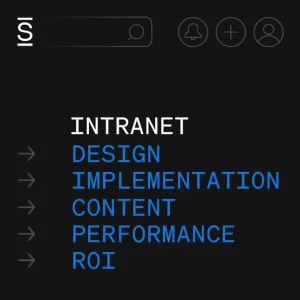Improving employee engagement and company culture have the power to impact everything in your business: growth, innovation, employee turnover, customer success, profits, and the list goes on! So it’s not uncommon for companies to look for employee engagement ideas. Unfortunately, there is a lot of questionable advice on the intranet on the topic of how to improve employee engagement. Despite what you may have read, while employee engagement is important, you can’t simply give employees frozen yogurt coupons and expect a cultural transformation.
Here are 10 practical tips on how to improve employee engagement that are research-backed, reasonable to implement, and drive results:
Improving Employee Engagement Tip #1: Engage employees in a broader purpose
Surprisingly, in aSimpplr Research study on employee engagement, the most statistically significant key driver of engagement is an employee’s resonance with the company’s greater purpose and cultural norms. In short, what the company stands for matters. We associate our jobs as an extension of our own personal brands. With this knowledge, companies can appreciate the need for more internal marketing to reaffirm and crystalize how the organization is making a positive dent in the world.
Improving Employee Engagement Tip #2: Over-communicate strategy and goals
Most companies are terrible at goal alignment. According to MIT research, only 13% of frontline managers can recite company priorities. It is simply not enough to flash goals up once a quarter in a company meeting. We all have day jobs and succumb to our respective to-do lists. Interestingly, Simpplr Research found that employees who have a good understanding of strategic priorities and how their contribution matters are twice as engaged as those who can’t recite priorities.
Improving Employee Engagement Tip #3: Focus efforts on building employees’ personal networks
Think about the most impactful coworkers you’ve had over your career. Oftentimes they’re not the people that have all of the answers firsthand, but they very easily know where to get help. Employee success and employee engagement are oftentimes a function of their network! Once you understand the importance of personal networks, you should develop efforts that make it easier for employees to connect with their coworkers. Use technology to make it easier to find experts. Encourage projects across locations and departments to strengthen employee networks.
Improving Employee Engagement Tip #4: Encourage cross-functional projects
In 1965, psychologist Bruce Tuckman first came up with the memorable model “forming, storming, norming, and performing” when he published, “Developmental Sequence in Small Groups.” He described the sequence most teams follow on their way to high performance, noting that there is an evolution that requires trust-building and norming. Nothing encourages workplace trust and bolsters the community better than shared victories. The more cross-functional victories are had, the stronger the connections and the greater the collective employee engagement.
Improving Employee Engagement Tip #5: Get your leaders to actually lead
When Simpplr Research reviewed Glassdoor ratings from companies across the Wilshire 5000, it was striking to see how highly correlated employee reviews of both “Company Culture” and “Senior Management” were. In short, as goes the management so goes the culture. It is imperative that your leaders take accountability to inspire and engage employees. This is done with transparency and continuous communication. If you’re looking for tips on how to help your leaders become better communicators, see our blog post.
Improving Employee Engagement Tip #6: Ensure employees are getting new skills
A big part of improving employee engagement comes from conquering personal challenges. It’s human nature to be engaged when we’re learning something new, even if there is no rational or economic incentive for doing so. That’s why we pick up hobbies. The downside is, when we’re not getting better at something, we’re typically getting worse. This drains the psyche and is an employee engagement killer. Organizations and managers should work closely with employees to identify growth areas and keep an ongoing feedback loop.
Improving Employee Engagement Tip #7: Give employees autonomy and encourage employee ownership
According to best selling author Daniel Pink who studied employee engagement extensively in his book “Drive”, autonomy is an important driver of employee engagement. Especially in most knowledge worker roles where tasks require creative thinking and problem solving, employees thrive more when given space to take on challenges in their own direction. As a manager, if you want to learn how to improve engagement, simply focus the employee on the outcome and give them the autonomy to reach it without breathing down their necks.
Improving Employee Engagement Tip #8: Train your managers on employee engagement and your cultural norms
There is an old adage that people don’t quit their companies — they quit their bosses. From a statistical perspective, this isn’t necessarily true as our research shows the organizational alignment and cultural aspects show a higher impact. Nonetheless, managers have a tremendous impact on improving employee engagement. So efficiently training them will help with turnover. Admittedly, it is really hard to create engaging middle-managers at scale. Consider diversifying the employee experience with more cross-functional projects and more engagement from skip-level managers.
Improving Employee Engagement Tip #9: Prove that you listen to employees
It’s not enough to survey employees. It’s not even enough to survey employees and say “we hear you.” Rather, systematically tackle the most pressing employee experience challenges. Use surveys and data – they are your friend. Operationalize the process of corrective action based on employee engagement surveys. Spend time in your company meetings showing what progress has been done. Keep it authentic by surveying employees on whether the actions are working. And most importantly, keep the process going continuously. There are always areas to improve. The worst thing you can do is forgo employee feedback at the expense of other business.
Improving Employee Engagement Tip #10: Be proactively transparent with internal communications
We’ve all worked for companies that have lectured us not to gossip or to “always assume positive intent” but that just isn’t how our primitive minds work. When employees are left in the dark, negative assumptions fill those voids. Organizations that preach like this without openly sharing information with employees are subjecting a double standard. Plus, transparency saves a lot of time and effort because it prevents the organization from having to go on the offensive against fake news. When there is little news to withhold, there is less room for gossip.
Looking to go a little deeper on improving employee engagement?
Download our eBook Strategies to Improve Employee Engagement where we show how to incorporate the key drivers of engagement into your strategy and how to measure the results of your efforts and continuously improve.














